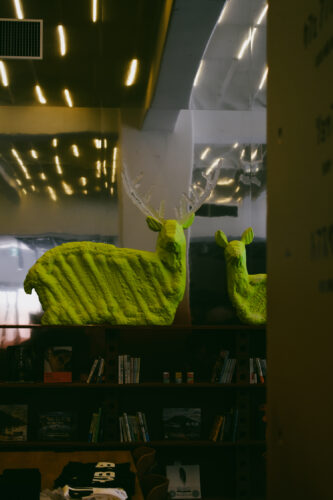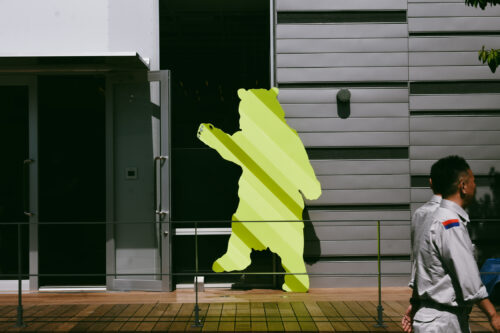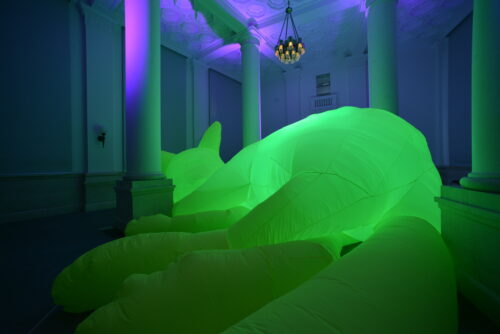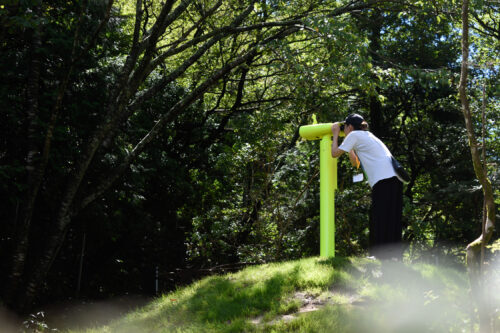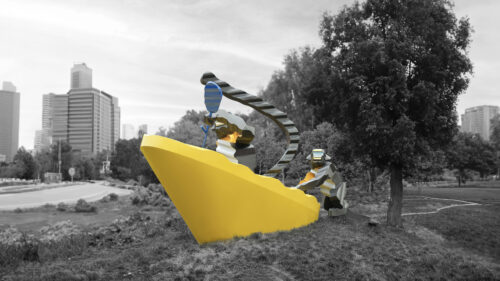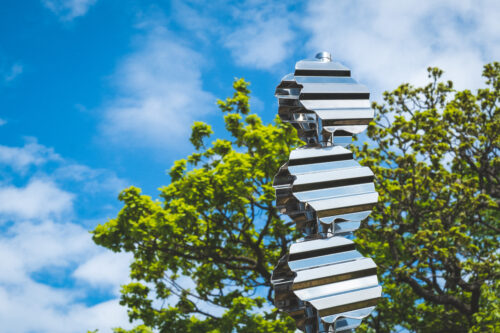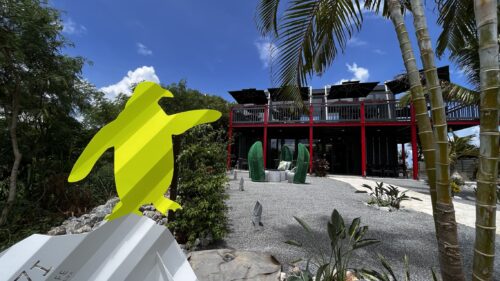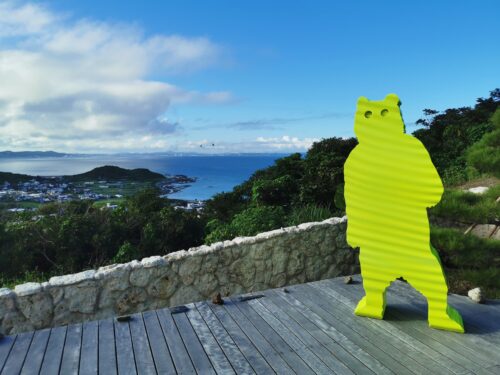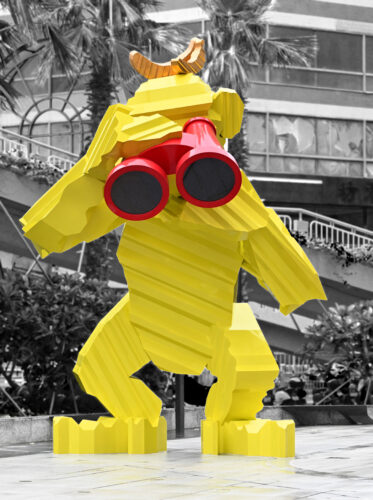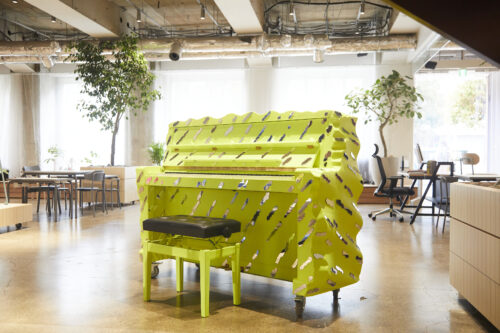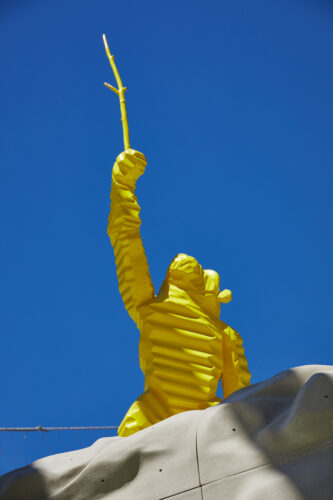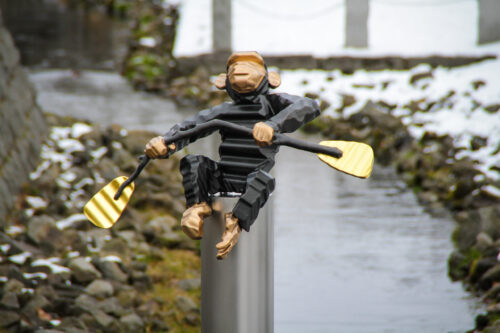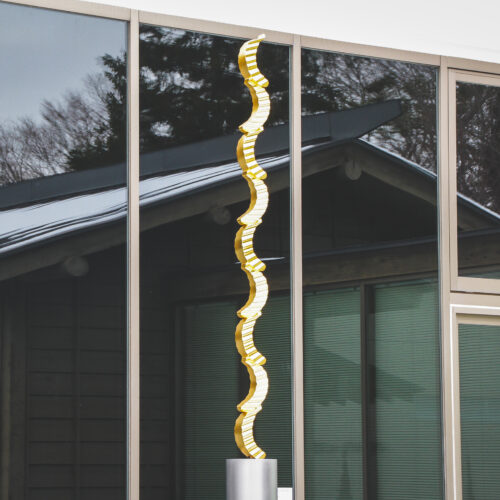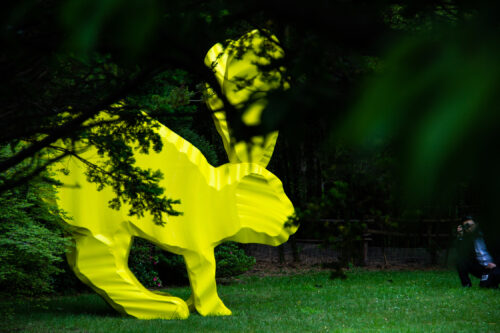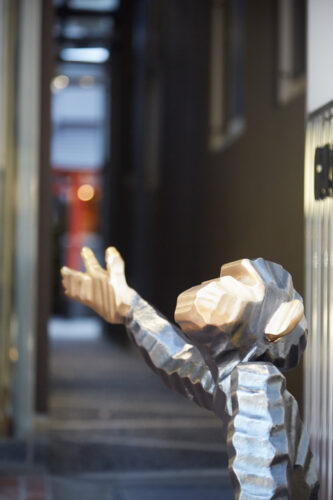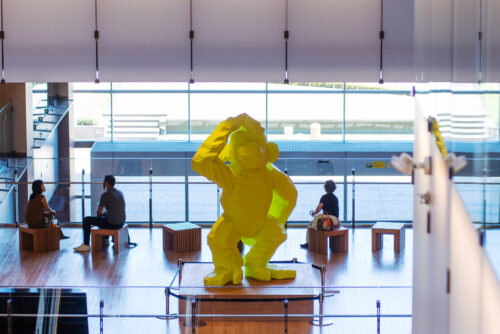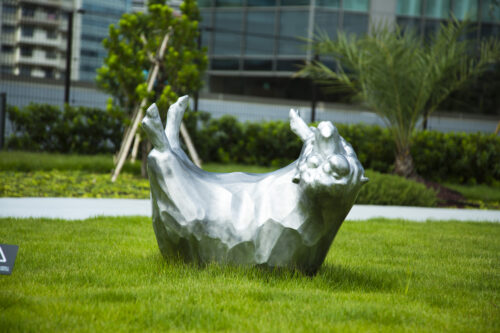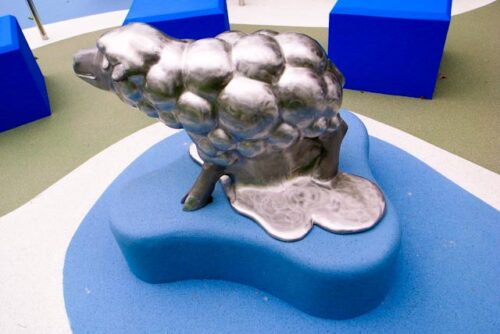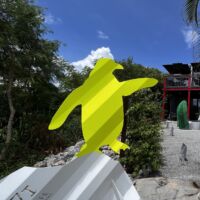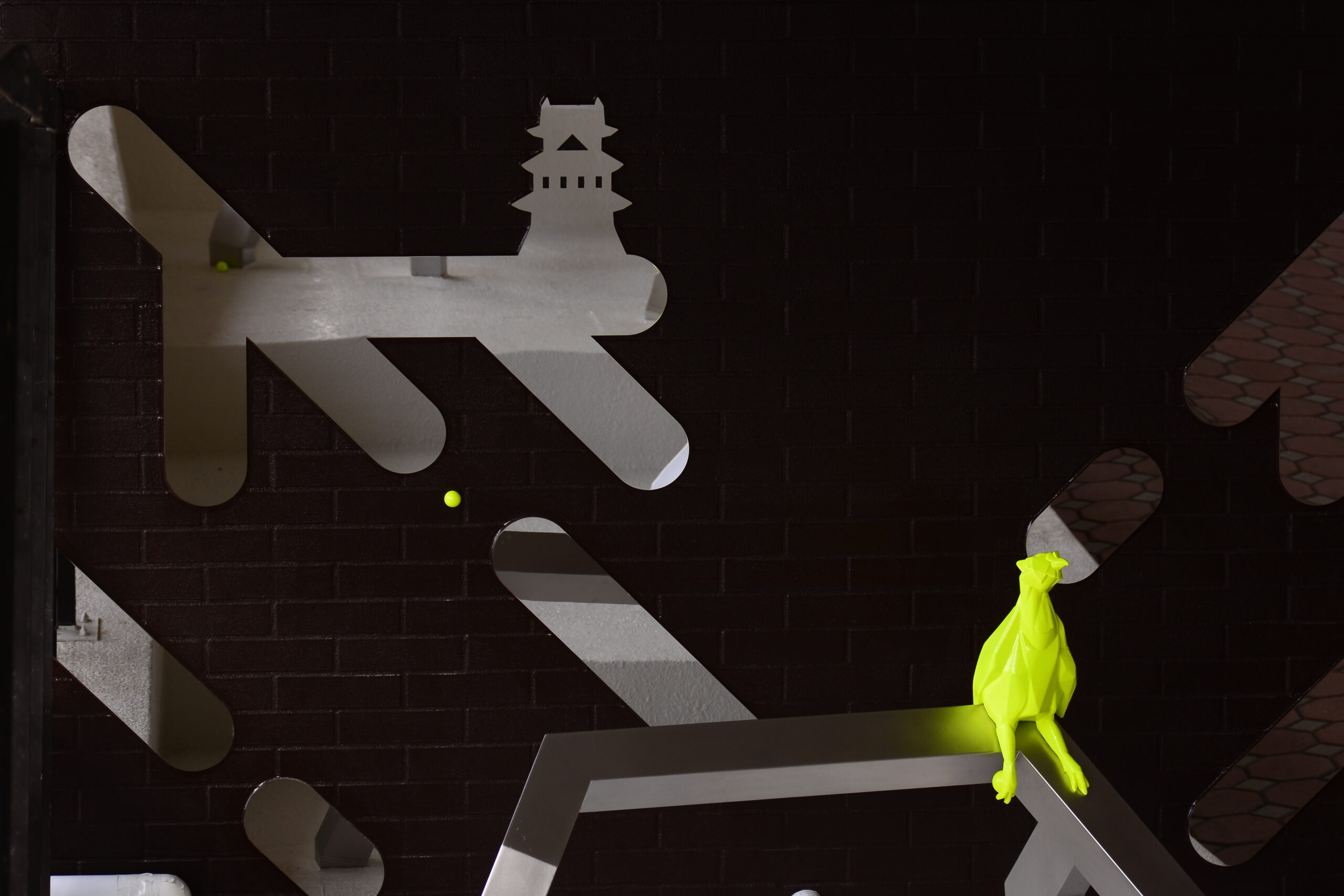
IYMMTRSTN.
Regarding the Art Project
The station plays a crucial role in our town. It is where the stories begin for both those who travel from afar and those who come from distant places. Moreover, the station itself holds its own narrative. We invite you to discover the story within the art at Inuyama Yuen Station. Through art, we aspire for everyone to develop an affection for this station.
Artistic Director:
Toshio Shimizu
犬山遊園駅 アートプロジェクトについて
駅はまちの要です。遠くに行く人も遠くから来た人も駅から物語が始まります。そして駅そのものにも物語があります。犬山遊園駅のアートにその物語を見つけてください。アートを通じてみなさんがこの駅を好きになってほしいと願っています。
アーティスティックディレクター
清水敏男
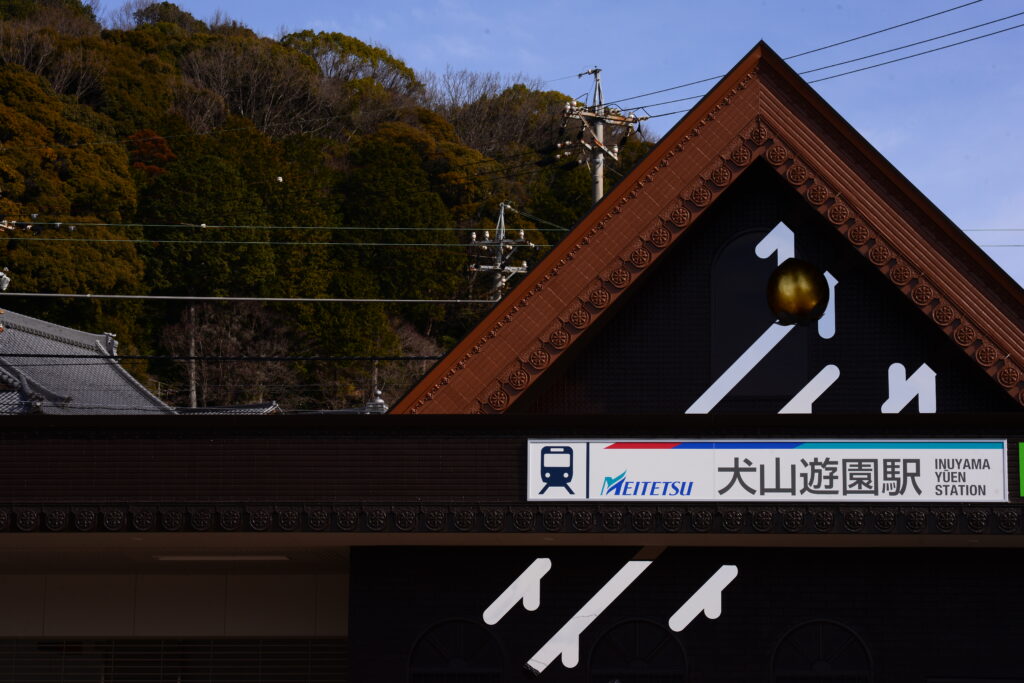
Regarding the Artwork
The mirrored panels on the station building’s walls represent the abundant flow of the Kiso River. The golden peaches are motifs that have long symbolized longevity, prosperity, and the flourishing of descendants. Together, they depict the history of Inuyama, which has developed alongside the Kiso River, as well as its future prosperity.
During the creation of the artwork, we had the opportunity to listen to the local residents’ stories and memories about Inuyama, which instilled a strong sense of affection and pride. We compiled these into “INUYAMA PUBLIC STORIES” and projected them onto the station building’s windows as silhouettes of shadow puppets, evoking the essence of Inuyama.
The artwork inside the station premises was inspired by the legend of Momotaro (Peach Boy), which is widely known in the Inuyama area. It features a dog with kibi-dango (millet dumplings) perched on its nose, a monkey sitting on a Kiso cypress raft, gazing at Inuyama Castle, and a pheasant holding tightly onto kibi-dango, feeling a little tired from waiting. Until Momotaro arrives to gather them, why not enjoy the seasons of Inuyama together with these three companions?
WA!moto.
“motoka watababe”
犬山遊園駅 アートワークについて
駅舎壁面の鏡面パネルは、木曽川の豊かな流れを表現しています。 金色の桃は古くから不老長寿や子孫繁栄の象徴とされてきたモチーフです。 これらは、木曽川とともに発展してきた犬山の歴史と、今後の更なる繁栄を表しています。
アートワークの制作にあたり、犬山の歴史や思い出を地元の方々から伺い、愛着と誇りを強く感じることができました。 それらを「犬山パブリックストーリーズ」として編集し、犬山を感じさせる影絵のシルエットとして駅舎の窓に投影しました。
駅構内のアートワークは、犬山周辺に伝わる「桃太郎伝説」をもとに制作しました。 きび団子を鼻に乗せたイヌ、木曽檜の筏(いかだ)にまたがり犬山城を眺めるサル、きび団子を握りしめ、少々待ちくたびれてしまったキジ。桃太郎が迎えにくるまで、3匹と一緒に犬山の四季を楽しみませんか。
WA!moto.
“motoka watababe”
INUYAMA PUBLIC STORIES
The dog, monkey, and pheasant sculptures on the Inuyama station platform are engaged in conversation while waiting for Momotaro to arrive. They sing and even rap about Inuyama, and although you may expect to hear a story about Momotaro, they also mention Oni (demons) and Urashima Taro!
犬山 パブリック ストーリーズ
ホームで桃太郎を待つイヌ・サル・キジが、何やら話をしています。 桃太郎の話……と思いきや、犬山のことを歌ったり、ラップにしたり、鬼や浦島太郎も登場 !?
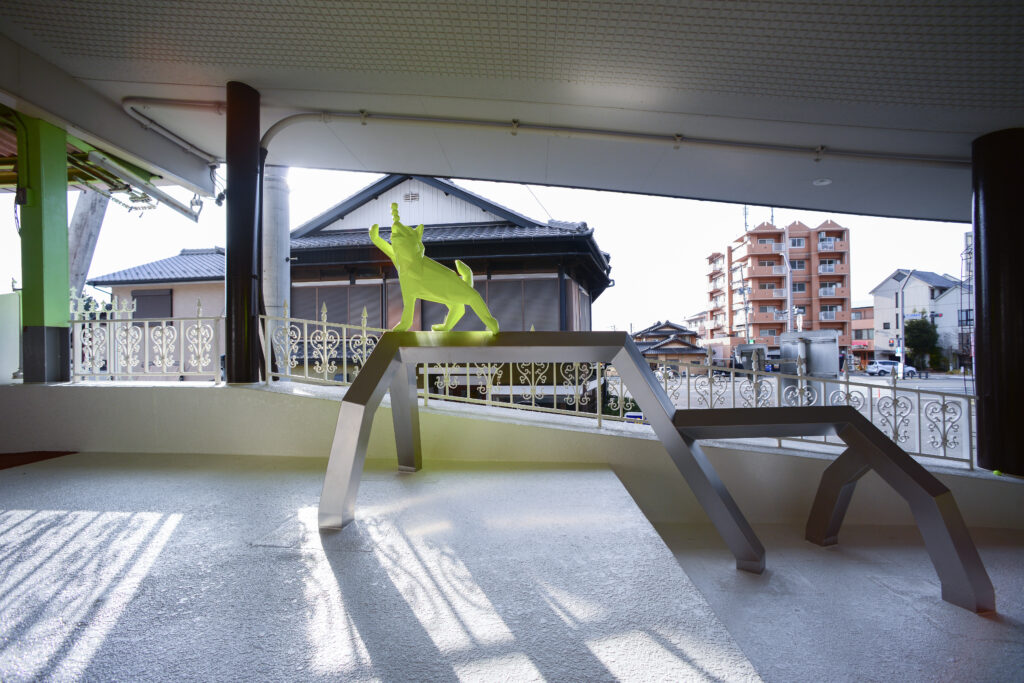
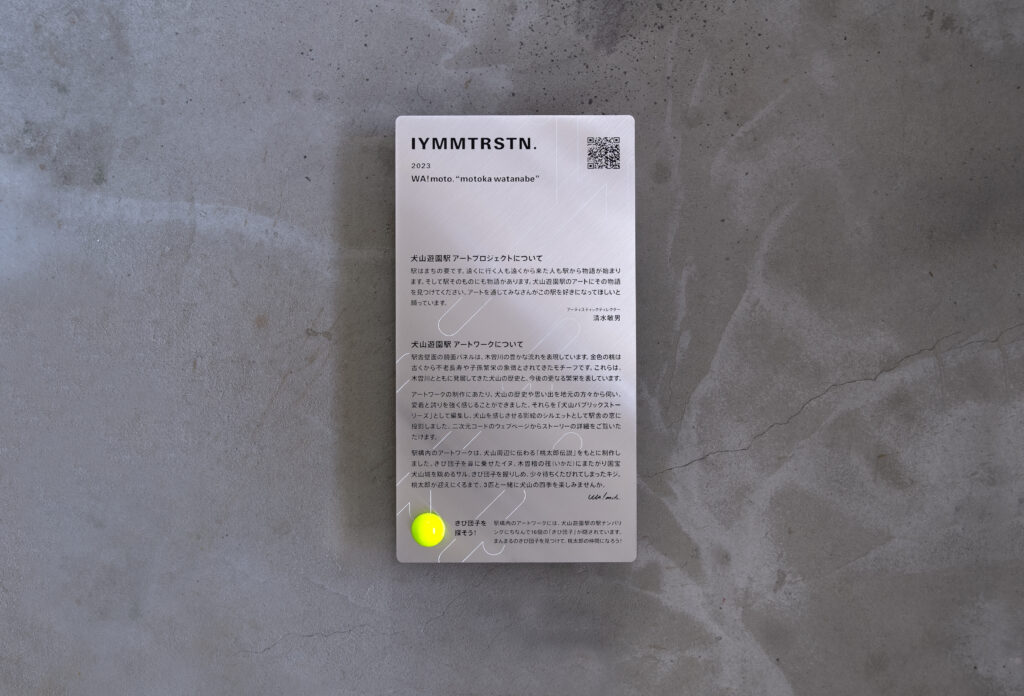
By scanning the QR code on the signboard, locals can access “INUYAMA PUBLIC STORIES” a content that condenses the history and memories of Inuyama. Based on shadow puppetry, theatrical troupe “Mamagoto” created a sound drama for visitors to enjoy.
After dusk, visitors can enjoy the shadow puppetry projections on the station building’s windows while waiting on the platform with three dog sculptures for Momotaro to arrive, or before visiting Inuyama. Feel free to enjoy in your preferred style.
このアートワークは銘板のQRコードを読み込むことで、地元の方々に伺った犬山の歴史や思い出を凝縮したコンテンツ「犬山パブリックストーリーズ」として、影絵作品をもとに劇団ままごとが制作した、サウンドドラマをお楽しみいただけます。
夕方以降、駅舎の窓に投影される影絵を見ながら、ホームで3匹の彫刻と一緒に桃太郎を待ちながら、あるいは犬山を訪れる前に。お好きなスタイルでお楽しみください。
INUYAMA PUBLIC STORIES
I missed you
「君想フ」
Audio Content [ Written by Takuo Miyanaga (Mamagoto) ] Man = Takeshi Fukuda (Nakano Shigeki + Frankens) Woman = Yoko Tachikura (Seinendan / Nashinasu)
※ 音声コンテンツ[作:宮永琢生(ままごと)]男 = 福田毅(中野成樹+フランケンズ)女 = 北村恵(ワワフラミンゴ)
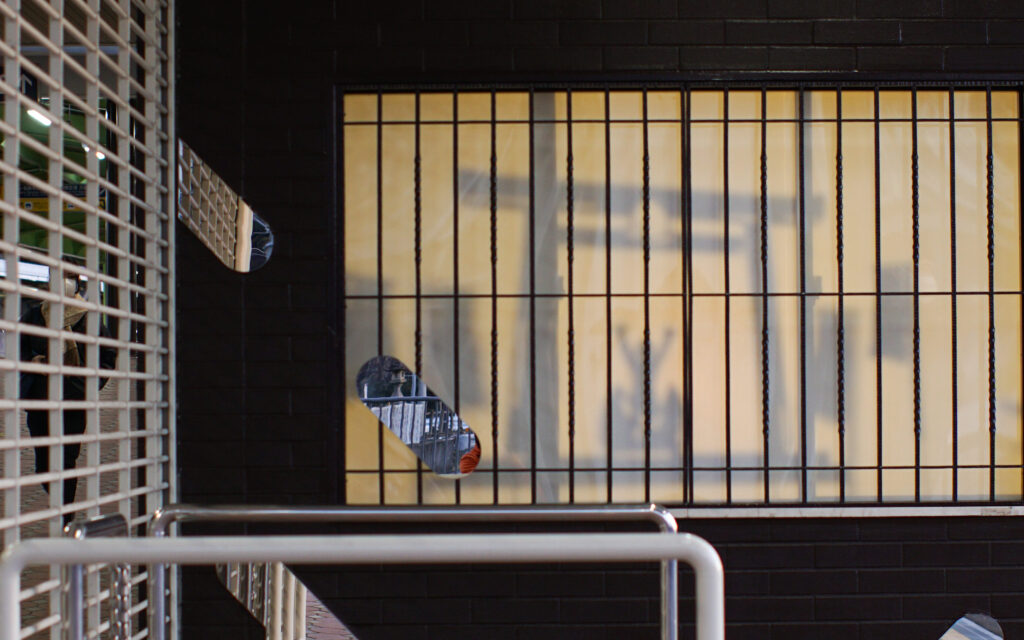
INUYAMA PUBLIC STORIES
-About the terrain of Inuyama-
犬山の地形
INUYAMAYUEN-Eeeeeki !!!!!
Audio Content [ Lyrics: Niina Hashida (Mamagoto) / Composition: Takuma Aoki (PaunchWheel) ] Wrap = Niina Hashida (Mamagoto) Song = Takuma Aoki (PaunchWheel), Takuo Miyanaga (Mamagoto)
※ 音声コンテンツ[作詞:端田新菜(ままごと)/作曲:青木拓磨(パウンチホイール)]ラップ=端田新菜(ままごと)歌=青木拓磨(パウンチホイール)、宮永琢生(ままごと)
The area surrounding Inuyama Yuen Station has been dubbed “Japan’s Rhine” due to the steep, Kiso River-eroded cliffs and the picturesque sight of Inuyama Castle standing along the river. While Rhine boat tours are currently suspended, the valley remains a popular spot for activities such as rafting. In the past, the surrounding terrain served as a castle (Unuma Castle) during the Muromachi and Azuchi-Momoyama periods, and later as a restaurant during the Showa era.
Moreover, the riverbed of the Kiso River features “chert,” a distinct reddish-brown rock that holds significant geological importance and has been known to yield valuable fossils, making it an invaluable location for geological research.
犬山遊園駅周辺は、木曽川によって侵食され切り立った渓谷と、木曽川沿いに立つ犬山城の姿がドイツのライン川を思わせることから「日本ライン」と名付けられています。
ライン下りは休止となりましたが、渓谷は現在もラフティングなどのアクティビティに活用され、周辺の地形は室町・安土桃山時代には城郭(鵜沼城)として、昭和期には料亭などに使われていました。
また、木曽川の河原は「チャート」と呼ばれる赤茶色の岩石が表出していて、地質学上重要な化石が発見されたこともある貴重なスポットとなっています。
INUYAMA PUBLIC STORIES
-Seasons of Inuyama: Spring-
犬山の四季 – 春 –
「はやく来ないかなぁ 春」
Can’t spring arrive soon?
Audio Content [ Written by Niina Hashida (Mamagoto) ] Dog = Niina Hashida (Mamagoto) Monkey = Takuo Miyanaga (Mamagoto) Pheasant = Takuma Aoki (PaunchWheel)
※ 音声コンテンツ [作:端田新菜(ままごと)]イヌ=端田新菜(ままごと)、サル=宮永琢生(ままごと)、キジ=青木拓磨(パウンチホイール)
Spring is the season of cherry blossoms. From within Inuyama Castle to the banks of the Kiso River, the entire castle town is adorned in shades of pink. You can take a stroll along the riverside promenade or enjoy the scenery from a sightseeing boat. Another option is to ride in a rickshaw and appreciate the cherry blossoms and riverside views from a different perspective.
In early April, the Inuyama Festival takes place on the first Saturday and Sunday, further enhancing the lively atmosphere of spring in Inuyama.
春は桜の季節。犬山城内から木曽川河畔にかけて、城下一帯が桜色に染まります。
河畔の遊歩道を歩くもよし、遊覧船で川からの風景を楽しむもよし。人力車に乗って少し違う目線から桜や河畔の風景を楽しむこともできます。
4月の第一土曜・日曜には犬山祭が開催され、春の犬山は一層盛り上がりを見せます。
INUYAMA PUBLIC STORIES
-Straw-Wrapped Festival Boats-
巻藁舟 / 川祭りの山車
The Ship of Gratitude
「ありがとうの舟」
Audio Content [ Composition: Takuma Aoki (PaunchWheel) ] Talk = Yoko Tachikura (Seinendan / Nashinasu) Song / guitar = Takuma Aoki (PaunchWheel)
※ 音声コンテンツ[作詞・作曲:青木拓磨(パウンチホイール)]声=立蔵葉子(青年団/梨茄子)歌・ギター=青木拓磨(パウンチホイール)
In the past, there was a river festival called “Kawamatsuri” held at Mikami Inari Shrine in Inuyama. Numerous lanterns adorned the area, and graceful straw-wrapped boats, accompanied by traditional music, leisurely floated along the Kiso River. However, during the mid-Showa period, the construction of Inuyama-Toshukō (Line Oōhashi) on the Kiso River led to the disappearance of the festival.
Currently, efforts are underway to revive the tradition of the straw-wrapped festival boats.
かつて犬山で行われていた三光稲荷神社の川祭。たくさんの提灯が飾られ、お囃子を乗せた巻藁舟が、木曽川をゆったりと進む優美な姿…
しかし、木曽川に犬山頭首工(ライン大橋)が建設された昭和中期に、川祭は消滅してしまいました。
現在、巻藁舟の再興に向けた動きが始まっています。
INUYAMA PUBLIC STORIES
-Inuyama Festival-
犬山祭の車山
Hold your hand.
「手をつないで」
Audio Content [ Written by Takuo Miyanaga (Mamagoto) ] Woman = Megumi Kitamura (Wawa Flamingo)
※ 音声コンテンツ[作:宮永琢生(ままごと)]女=北村恵(ワワフラミンゴ)
The Inuyama Festival, which takes place annually on the first Saturday and Sunday of April, is a vibrant celebration featuring 13 elaborately decorated festival floats known as “Yamayama,” each carrying karakuri puppets.
The festival offers various highlights, including the presentation of karakuri performances, the dramatic direction changes known as “Donden,” and the stunning “Yoyama” evening procession with its 365 beautifully lit lanterns.
Originating in the 12th year of the Kan’ei era (1635), the Inuyama Festival initially revolved around parades featuring elaborately crafted creations and costumed processions known as “Nerimono.” Over time, it gradually shifted its focus to the festival floats, becoming an entertainment-centered celebration.
例年4月の第一土曜・日曜に開催される犬山祭は、からくり人形を乗せた13輌の豪華絢爛な車山(やま)が練り歩くお祭り。
からくりの奉納や、「どんでん」と呼ばれる車山の方向転換、365個の提灯の火が鮮やかな「夜車山(よやま)」など、多くの見どころがあります。
寛永12(1635)年に始まった当初は、「練り物」と呼ばれる趣向を凝らした作り物や仮装の行列が中心だった犬山祭。次第に車山中心の、娯楽性の高い祭りになっていったと言われています。
INUYAMA PUBLIC STORIES
-Seasons of Inuyama: Summer-
犬山の四季 – 夏 –
Can’t summer arrive soon?
「はやく来ないかなぁ 夏」
Audio Content [ Written by Niina Hashida (Mamagoto) ] Dog = Niina Hashida (Mamagoto) Monkey = Takuo Miyanaga (Mamagoto) Pheasant = Takuma Aoki (PaunchWheel)
※ 音声コンテンツ [作:端田新菜(ままごと)]イヌ=端田新菜(ままごと)、サル=宮永琢生(ままごと)、キジ=青木拓磨(パウンチホイール)
Inuyama’s summer is adorned with fireworks and bonfires that illuminate the night’s river surface. It begins with the fireworks display at the Ukai opening ceremony, followed by a ten-day long fireworks festival held in August, bringing the area around Inuyama Yuen Station to life with bustling excitement.
The traditional cormorant fishing on the Kiso River has been practiced for over 1300 years, and it is said to have been carried out in Inuyama since the early Edo period. Did the people of that time also gaze at the bonfires in the same way…?
In Inuyama, daytime cormorant fishing is also conducted, offering the opportunity to appreciate the scenic beauty along the Kiso River, including Inuyama Castle, and marvel at the dexterity of the cormorant fishermen.
犬山の夏は、花火と篝火が夜の川面を彩ります。
鵜飼開きの花火に始まり、8月には10日間のロングラン花火が開催され、犬山遊園駅周辺は一年で最も賑わいを見せます。
木曽川での鵜飼は、1300年前から行われており、犬山では江戸時代初めごろから行われていたといわれています。当時の人々も同じように篝火を眺めていたのでしょうか…。
犬山では、夜だけでなく昼鵜飼も行っています。犬山城をはじめとする木曽川沿いの景観と、鵜匠の手さばきを楽しむことができます。
INUYAMA PUBLIC STORIES
-Kiso hinoki log storage area-
木曽檜の集積場
Taro has arrived !
「太郎が来た」
Audio Content [ Written by Takuma Aoki (PaunchWheel) ] Man = Takuma Aoki (PaunchWheel)
※ 音声コンテンツ[作:青木拓磨(パウンチホイール)]男=青木拓磨(パウンチホイール)
Inuyama has developed as a city known for its high-quality timber, particularly the renowned “Kiso hinoki” (Japanese cypress). Kiso hinoki has long been utilized as a construction material for castles and shrines, and since the 1700s, it has been used in the construction of the Naiku (Inner Shrine) of Ise Jingu.
Kiso hinoki, which is distributed from the Kiso region in Nagano Prefecture to the southern part of Hida and the Tokai region, is harvested and then transported downstream using the Kiso River. The logs, floated down one by one from upstream, are assembled into rafts when the river widens. Inuyama served as a relay base for these rafts.
With the gathering of people and goods centered around Kiso hinoki, Inuyama flourished and developed over time.
犬山は、良質な木材として有名な「木曽檜」の集積場として発展した都市です。
木曽檜は古くから城や神社の建築材として活用され、1700年代以降、伊勢神宮内宮の建材にも使用されています。
長野県木曽地域から飛騨南部、東濃地域に分布する木曽檜は、伐採されたのち木曽川を利用し下流に運ばれます。
上流から1本ずつ流された丸太を、川幅が広がった辺りで筏に組みます。この筏の中継基地であったのが犬山です。
木曽檜を中心に人・モノが集まり、犬山は発展していきました。
INUYAMA PUBLIC STORIES
-The Tower of the Young Sun-
若い太陽の塔
A New Humanity
「あたらしい人類」
Audio Content [ Written by Niina Hashida (Mamagoto) ] Woman = Niina Hashida (Mamagoto) Friends = Takuma Aoki (PaunchWheel), Yoko Tachikura (Seinendan / Nashinasu)
※ 音声コンテンツ [作:端田新菜(ままごと)]声 =端田新菜(ままごと)、相槌 =青木拓磨(パウンチホイール)、立蔵葉子(青年団/梨茄子)
“The Tower of the Young Sun” in Japan Monkey Park is a work by the renowned artist Taro Okamoto, known for his creations such as “Tower of the Sun” and “Myth of Tomorrow.” The sculpture of the “Young Sun” portion was gifted by Taro Okamoto himself, while the tower section was constructed by local volunteers.
Taro Okamoto frequently visited the Inuyama area due to his father’s connections and is said to have enjoyed the boat tours along the Kiso River, which were operational at that time.
Due to deterioration, the surrounding area was temporarily closed, but with the help of donations and support from many people, it was restored and has been open to the public since 2011, during the Heisei era.
日本モンキーパークにある「若い太陽の塔」は、「太陽の塔」「明日の神話」などの作品で知られる芸術家・岡本太郎の作品。「若い太陽」のオブジェの部分が岡本太郎から贈られたもので、塔の部分は地元有志が作ったそう。
岡本太郎は父の関係で犬山周辺をたびたび訪れており、当時営業していたライン下りを楽しんでいたと言われています。
老朽化により一時は周辺が閉鎖されていましたが、多くの人の寄付・支援もあり修復され、平成23(2011)年より一般公開されています。
INUYAMA PUBLIC STORIES
-Seasons of Inuyama: Autumn-
犬山の四季 – 秋 –
Can’t autumn arrive soon?
「はやく来ないかなぁ 秋」
Audio Content [ Written by Niina Hashida (Mamagoto) ] Dog = Niina Hashida (Mamagoto) Monkey = Takuo Miyanaga (Mamagoto) Pheasant = Takuma Aoki (PaunchWheel)
※ 音声コンテンツ [作:端田新菜(ままごと)]イヌ=端田新菜(ままごと)、サル=宮永琢生(ままごと)、キジ=青木拓磨(パウンチホイール)
Autumn in Inuyama is known for its breathtaking autumn foliage in the valleys. The “Ryannagari” boat tours, which began in the late Taisho period, ended in the 2000s. However, there is currently a limited-time operation of the “Momotaro Autumn Leaves Boat” that shuttles between Inuyama Castle and Momotaro Shrine.
Additionally, Inuyama Jakko-in, often referred to as the “Maple Temple of Owari,” is a historic temple that even Oda Nobunaga visited in the past. With approximately 1,000 vibrant maple trees, the sight of their colorful leaves is truly awe-inspiring.
秋の犬山は、渓谷の紅葉が見どころです。
大正後期に始まったとされるライン下り(観光船)は2000年代に終了しましたが、現在は犬山城と桃太郎神社とを行き来する観光船「桃太郎紅葉船」が期間限定で営業しています。
また、「尾張のもみじ寺」と呼ばれる犬山寂光院は、かつて織田信長も参詣した古刹。
約1000本ものモミジが色づく姿は圧巻です。
INUYAMA PUBLIC STORIES
-Momotaro Shrine-
桃太郎神社
Pray the ONI for the safety of giving birth
「安産鬼願」
Audio Content [ Written by Takuo Miyanaga (Mamagoto) ] Man = Takuo Miyanaga (Mamagoto)
※ 音声コンテンツ[作:宮永琢生(ままごと)]鬼:宮永琢生(ままごと)
Do you know the legend of Momotaro, a story that every Japanese person is familiar with? It is said that the setting of this story is in Inuyama. Inuyama is home to the symbolic “Momotaro Shrine” that represents the legend of Momotaro.
The current Momotaro Shrine was relocated in 1930, during the fifth year of the Showa era, from an old shrine called “Komori Shrine” that was said to be located at the foot of “Momoyama,” where Momotaro was last seen.
At the shrine, you will be greeted by sculptures and objects related to Momotaro. In the treasure hall, you can see various items associated with the Momotaro legend.
Every year on May 5th, which is Children’s Day in Japan, the “Momotaro Festival” is held, where children dress up as Momotaro and celebrate.
日本人なら誰でも知っている「桃太郎」のお話。その舞台が犬山だという言い伝えがあるのはご存知でしょうか。犬山に伝わる桃太郎伝説、そのシンボルであるのが「桃太郎神社」です。
現在の桃太郎神社は、この土地に古くからあった「子守社」というお社を昭和5(1930)年に移したものになります。「子守社」は桃太郎が最後に姿を消したと言われる「桃山」の麓にありました。
神社では桃太郎にちなんだオブジェがお出迎え。宝物館では桃太郎にまつわる品々を見ることができます。毎年5月5日のこどもの日には、子どもたちが桃太郎に扮する「桃太郎祭り」が開催されます。
INUYAMA PUBLIC STORIES
-Seasons of Inuyama: Winter-
犬山の四季 – 冬 –
Can’t winter arrive soon?
「はやく来ないかなぁ 冬」
Audio Content [ Written by Niina Hashida (Mamagoto) ] Dog = Niina Hashida (Mamagoto) Monkey = Takuo Miyanaga (Mamagoto) Pheasant = Takuma Aoki (PaunchWheel)
※ 音声コンテンツ [作:端田新菜(ままごと)]イヌ=端田新菜(ままごと)、サル=宮永琢生(ままごと)、キジ=青木拓磨(パウンチホイール)
In winter, Inuyama Naritasan (Daishoji) Temple is a popular spot for New Year’s visits in Inuyama. It is a branch temple of Shinshoji Temple located in Narita City, Chiba Prefecture, and is well-known for its prayers for traffic safety.
Moreover, at the Japan Monkey Centre, you can observe monkeys warming themselves by a bonfire during the winter season. This behavior of monkeys gathering around a fire is a famous example of their cultural behavior. It began when the staff of the center burned fallen trees caused by the Ise Bay Typhoon in 1959, and it has continued for over 60 years.
冬の犬山では、犬山成田山(大聖寺)が人気の初詣スポット。千葉県成田市にある新勝寺の別院で、交通安全祈願で有名です。
また、日本モンキーセンターでは、冬場、焚き火にあたるサルを見ることができます。
サルの文化的行動の一例として有名で、昭和34(1959)年の伊勢湾台風での倒木を職員が燃やしていたところ、子ザルが集まってきたことをきっかけに始まり、60年以上続いています。
INUYAMA PUBLIC STORIES
-The creatures of the Kiso River-
木曽川の生き物たち
Kiso-Ga-Waltz
「きそがワルツ」
Audio Content [ Composition: Takuma Aoki (PaunchWheel) ] Song = Takuma Aoki (PaunchWheel), Niina Hashida (Mamagoto), Takuo Miyanaga (Mamagoto)
※ 音声コンテンツ[作詞・作曲:青木拓磨(パウンチホイール)]歌=青木拓磨(パウンチホイール)、端田新菜(ままごと)、宮永琢生(ままごと)
The Kiso River, which flows along the northern border of Inuyama City, holds a special place in the hearts of those who were born and raised in Inuyama. People recount memories of playing along the riverbanks, fishing for catfish and carp, and enjoying fireworks in the pre-Showa era. The Itasenpara, a freshwater fish that used to be caught in the Kiso River system, is now designated as a natural monument by the Japanese government, showcasing its significance and rarity.
While it may be challenging to engage in riverbank activities today, the beauty of the sunset seen along the Kiso River and the view of the river from the Inuyama Castle keep continue to soothe our hearts. The river’s presence has always held a strong connection to the lives of the people of Inuyama, both in the past and present.
犬山市の北の境界を流れる木曽川。
犬山で生まれ育った方に話を聞くと、昭和期以前には、ナマズやコイを釣ったり、花火をしたりと、木曽川の河原で遊んだ思い出があると言います。
当時獲れたというイタセンパラは、木曽川水系に生息する貴重な淡水魚。現在では国の天然記念物に指定されています。
現在は川辺で遊ぶのは難しいかもしれませんが、木曽川河畔で見る夕陽の美しさや、犬山城の天守から望む木曽川の景色など、川のある風景は私たちの心を癒してくれます。
今も昔も、犬山の人々の暮らしと木曽川とは強い結びつきがあります。
Let’s find the KIBI-DANGO !
In the artwork inside the Inuyama Yuen Station, there are 16 hidden “kibi-dango” in reference to the station’s numbering. Find the perfectly round kibi-dango and become one of Momotaro’s companions!
きび団子を探そう!!!
駅構内のアートワークには、犬山遊園駅の駅ナンバリングにちなんで16個の「きび団子」が隠されています。まんまるのきび団子を見つけて、桃太郎の仲間になろう!
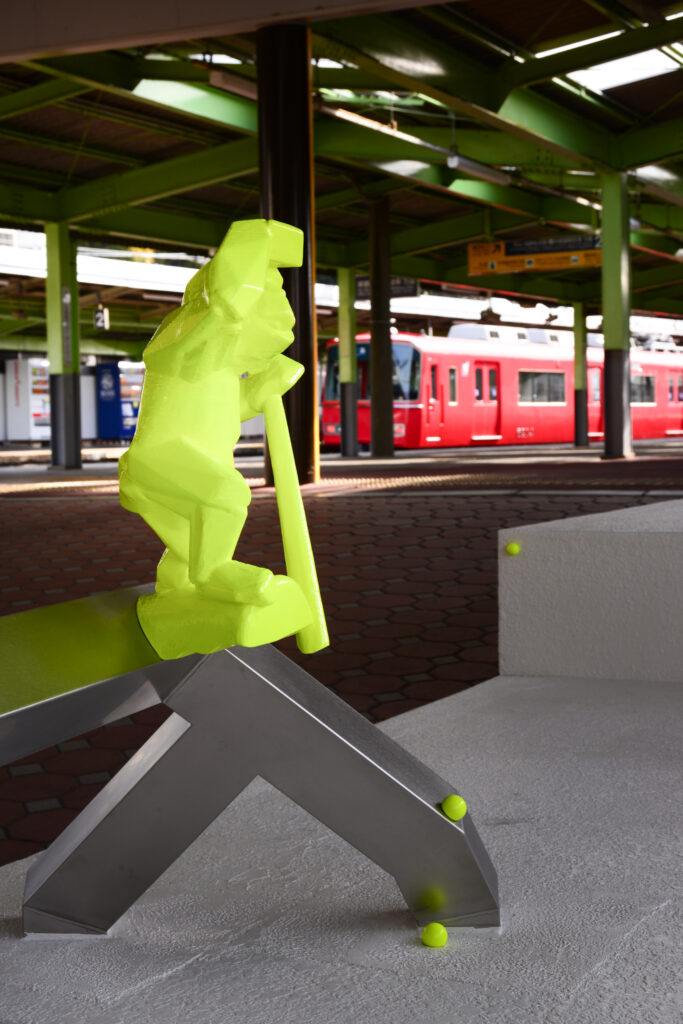
| DETAILS | |
|---|---|
| Title | IYMMTRSTN. |
| Artist | WA!moto. |
| Year | 2023 |
| Material | Mixed media |
| PLACE | 名古屋鉄道 犬山遊園駅 〒484-0081 愛知県犬山市犬山寺下24−1 犬山遊園駅 瑞泉寺Inuyama Yuen Station 24-1 Inuyama Zuisenji, Inuyama City, Aichi, Japan |
| CLIENTCLIENT | 名古屋鉄道 株式会社Nagoya Railroad Co.,Ltd. |
| COORDINATION | Toshio Shimizu Art Office |
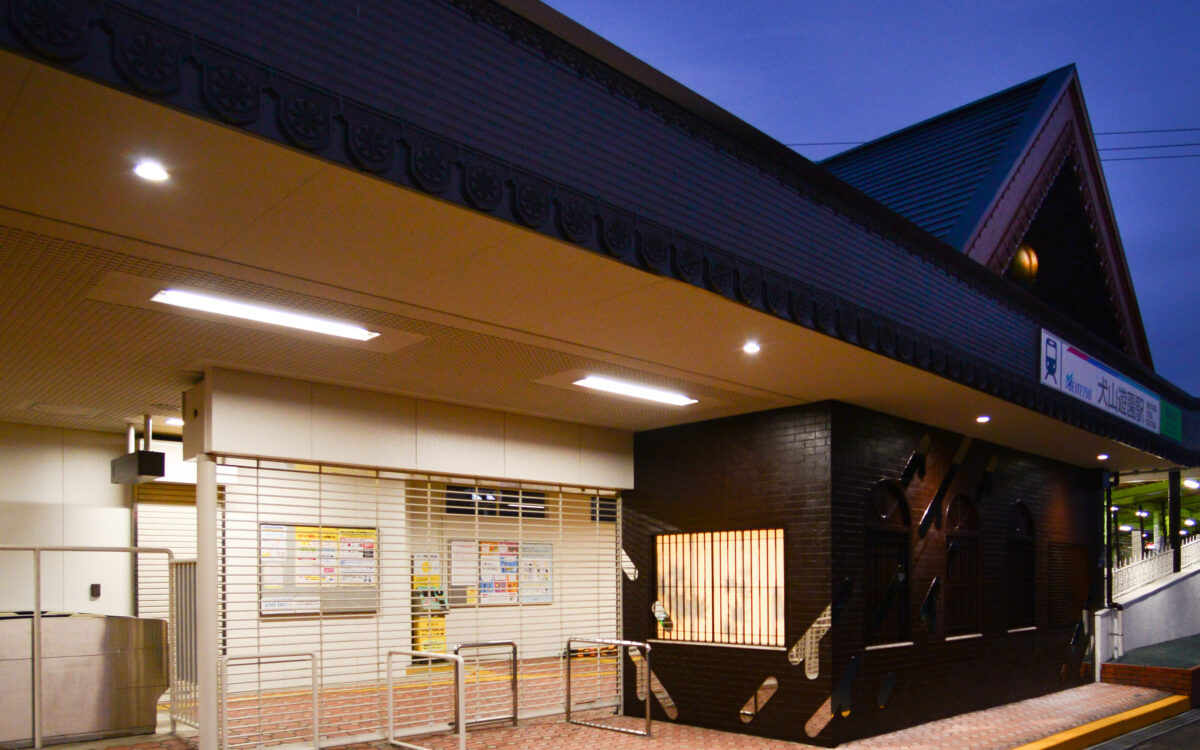
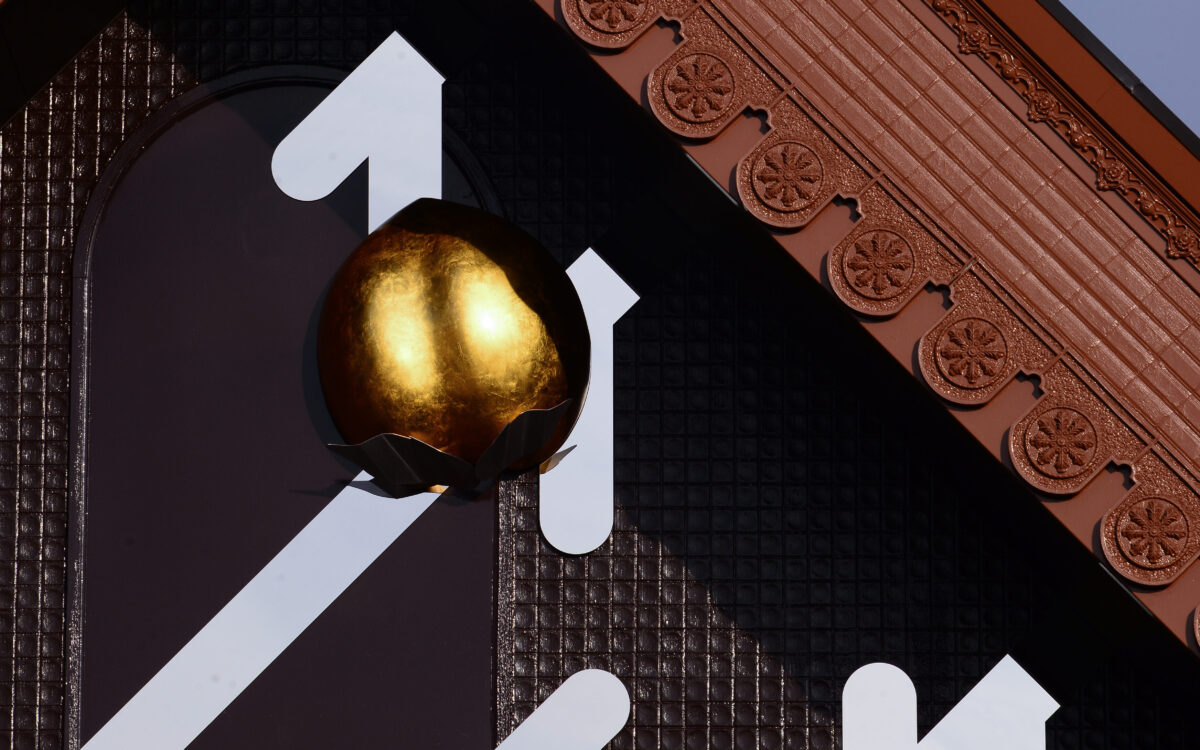
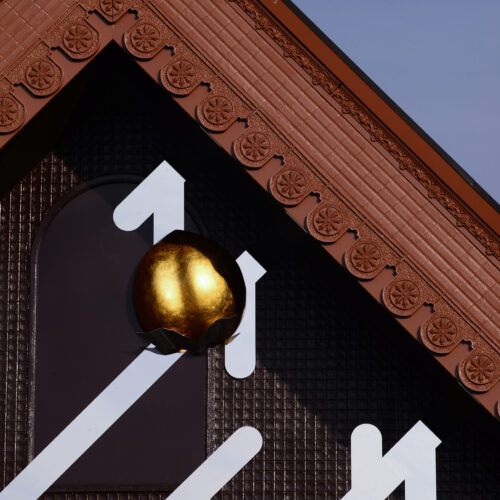
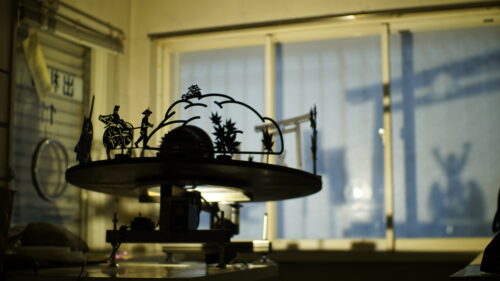
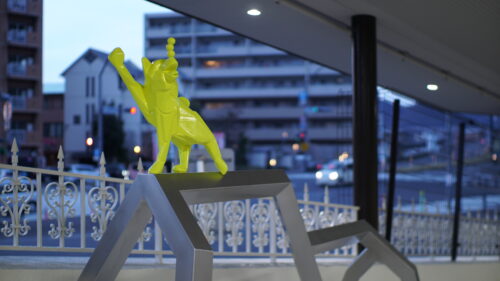
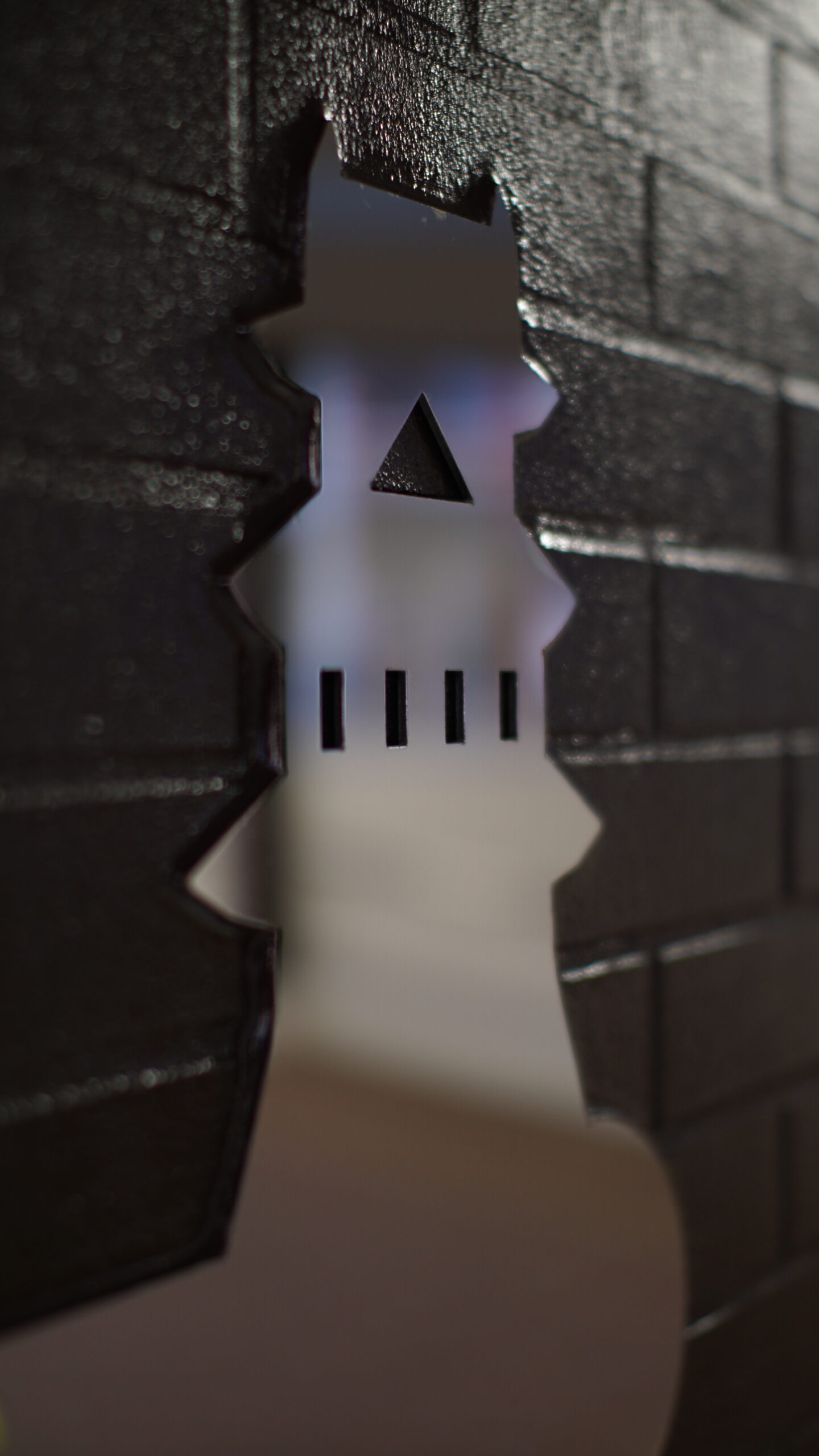
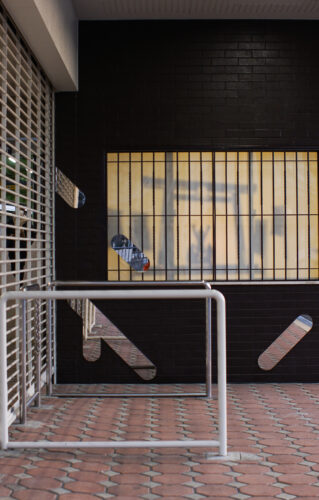
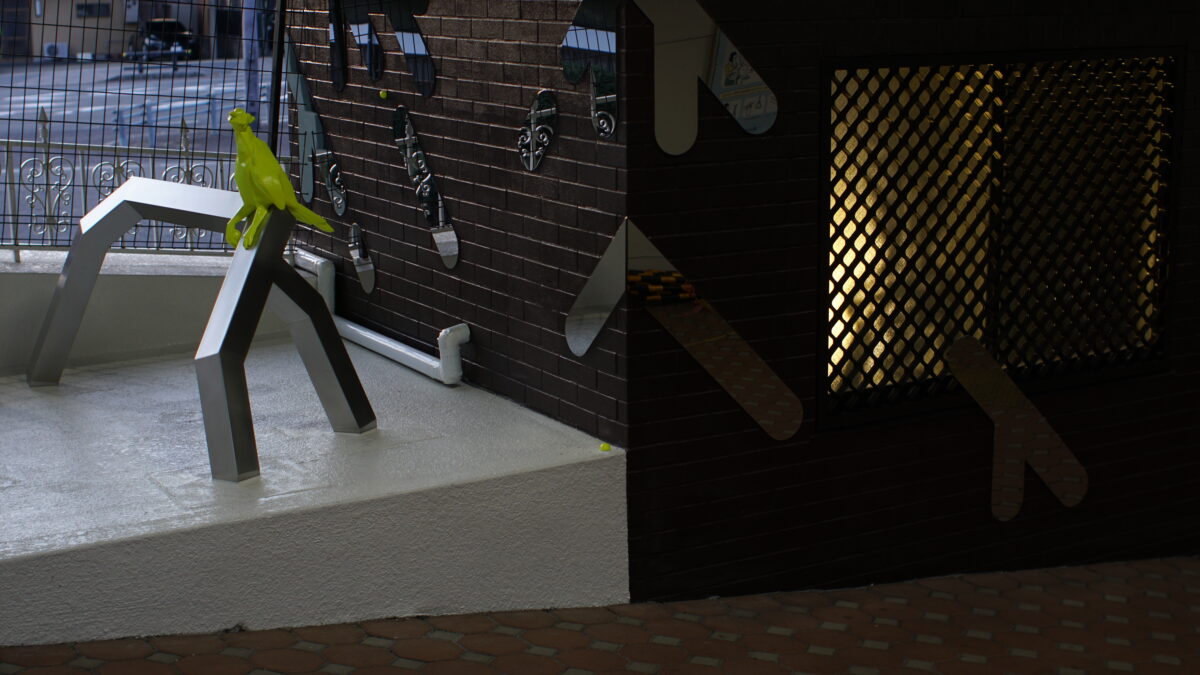
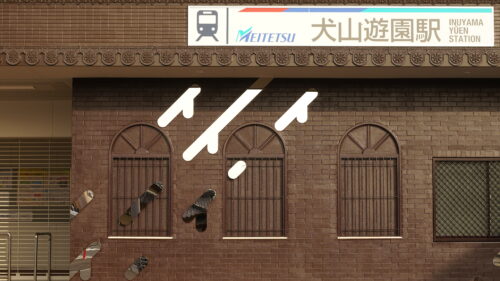
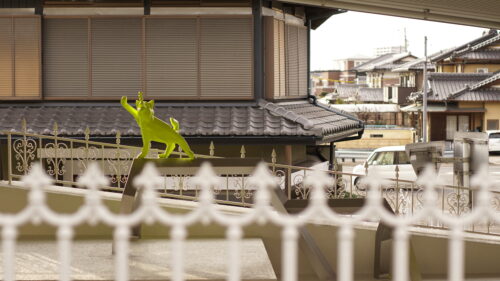
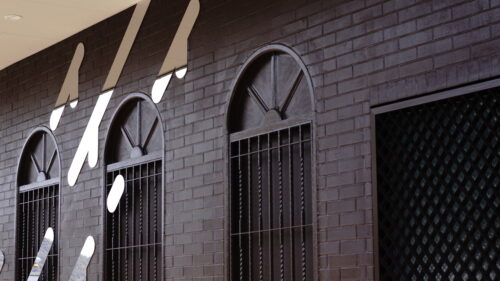
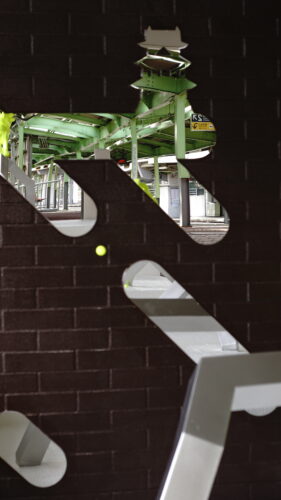
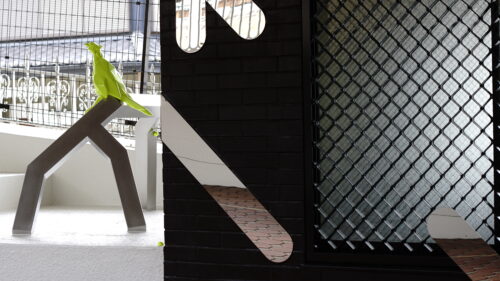
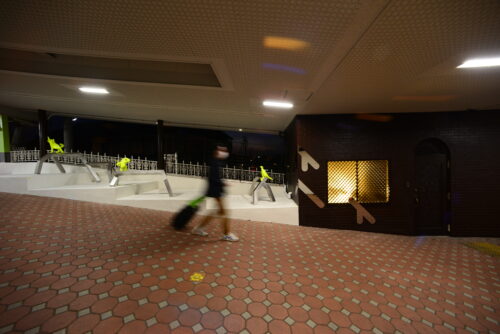
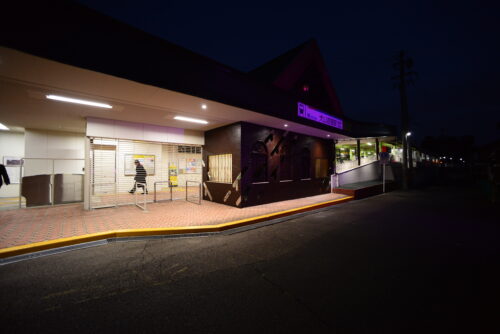
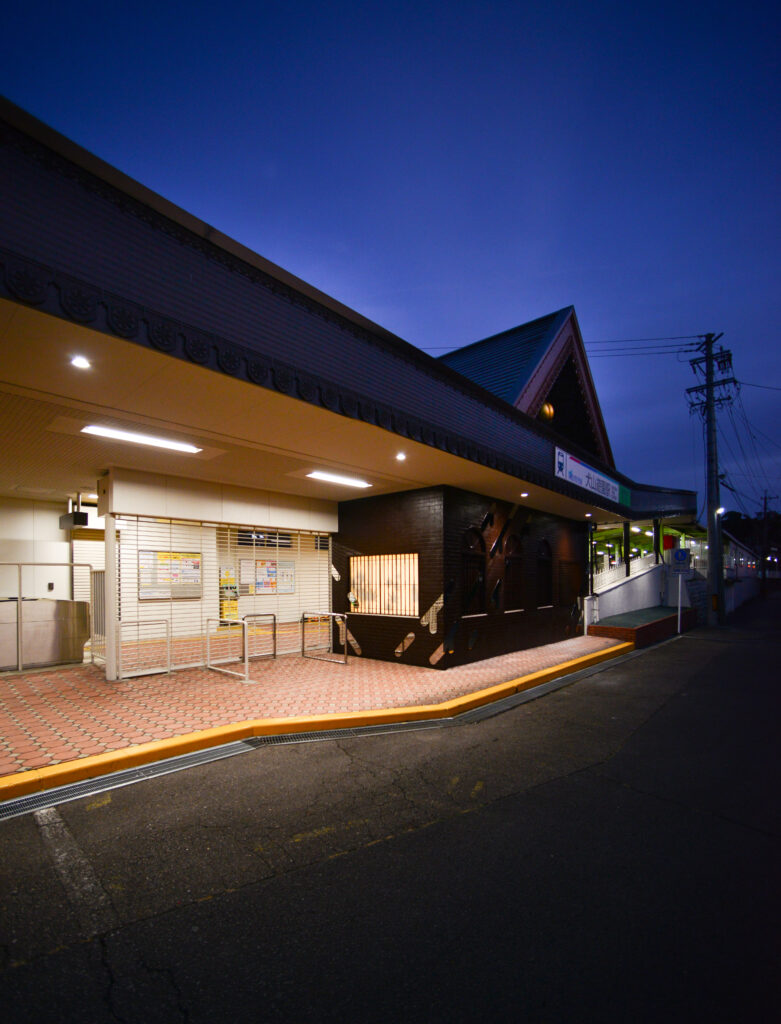
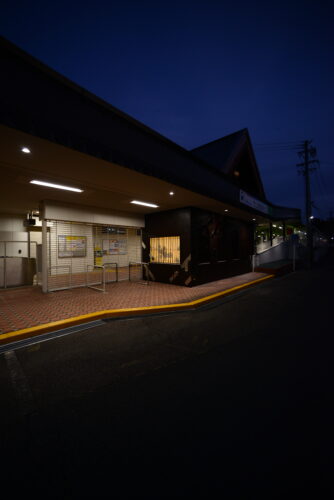
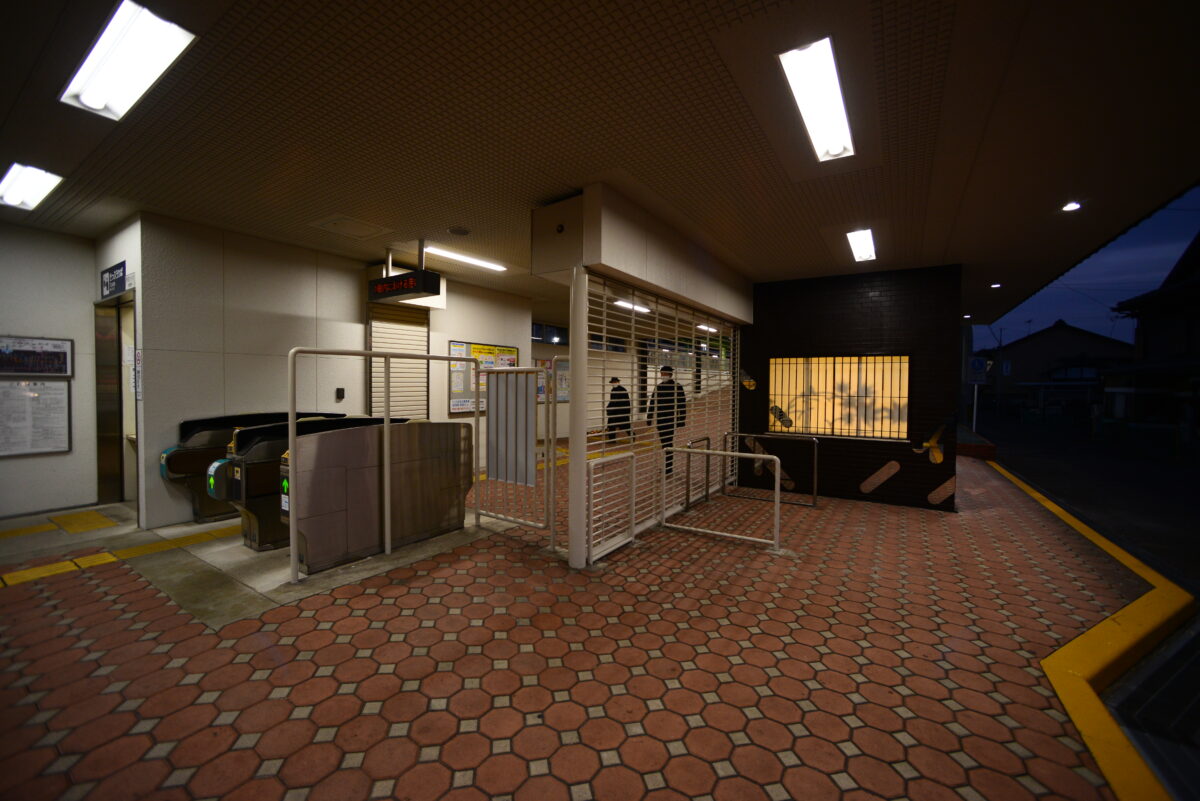
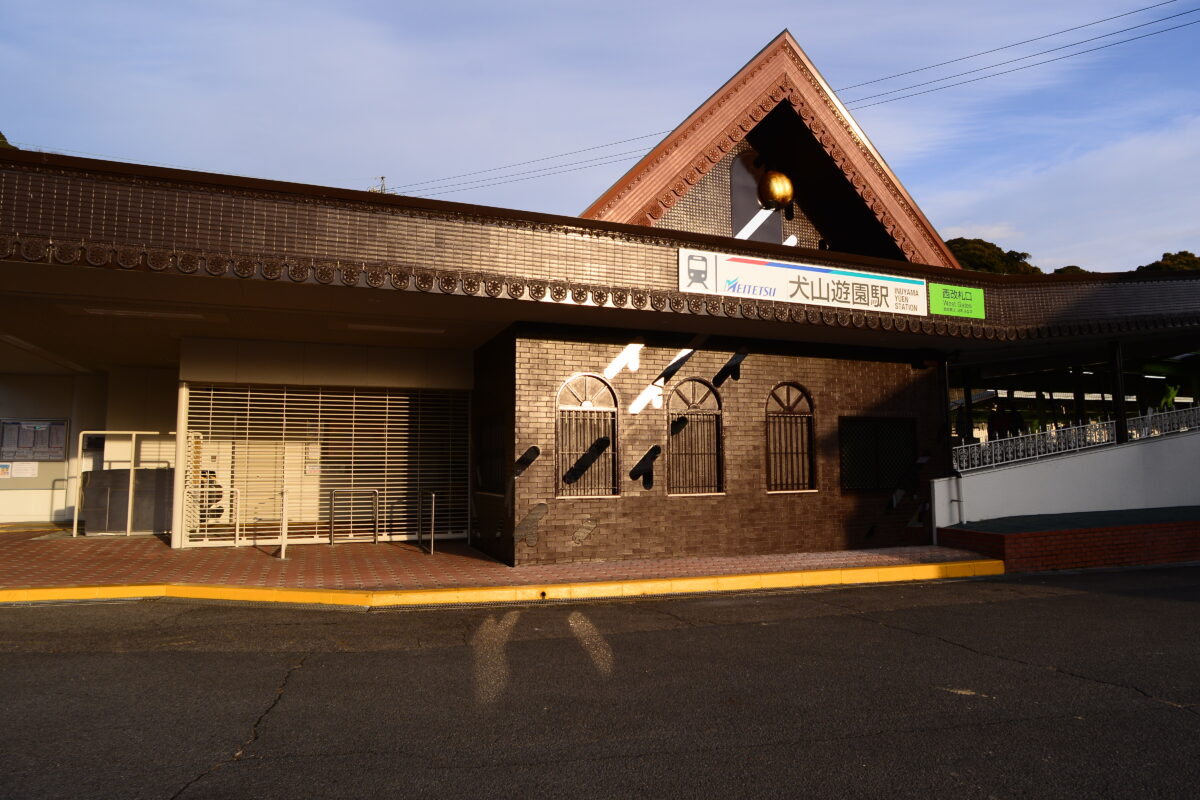
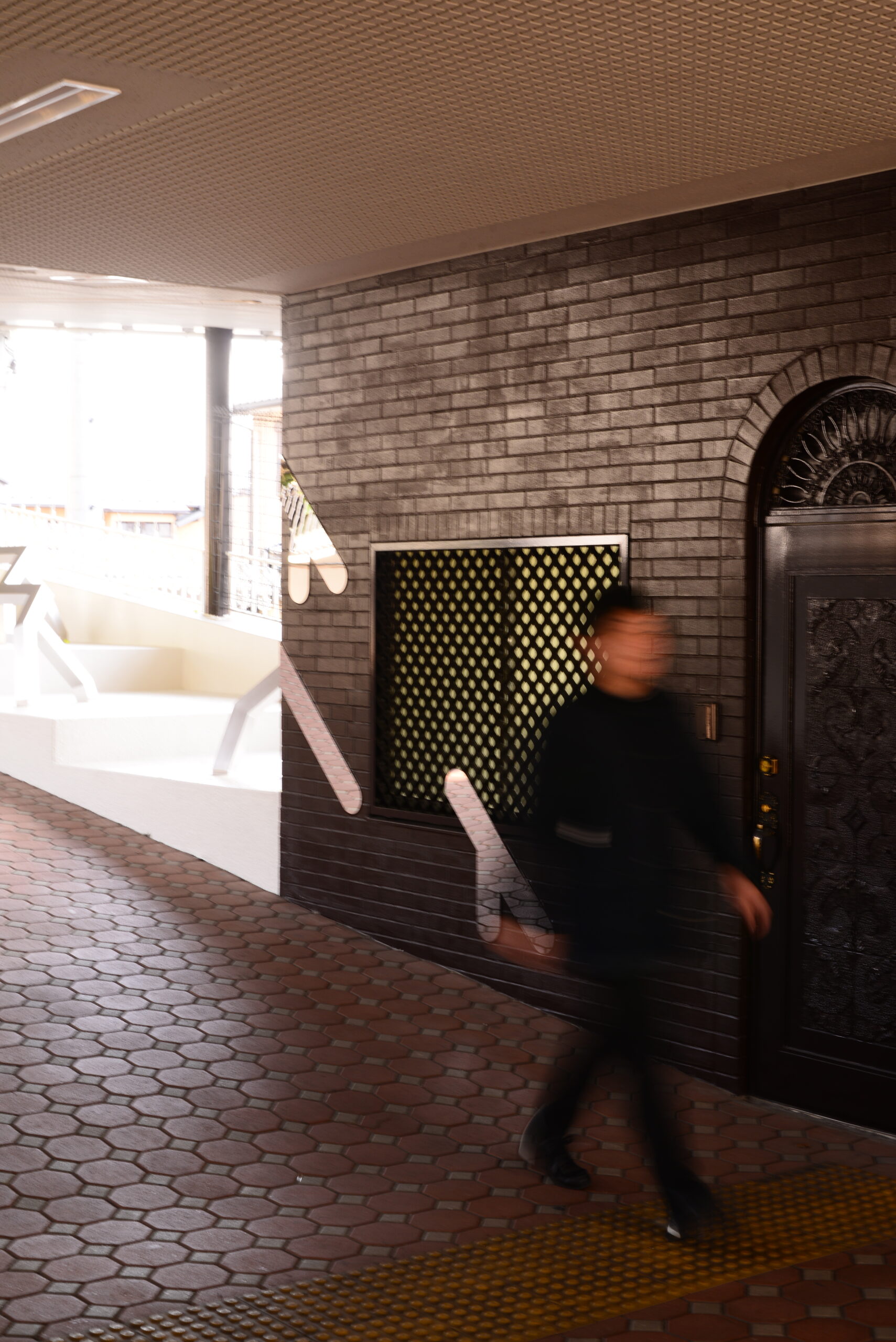
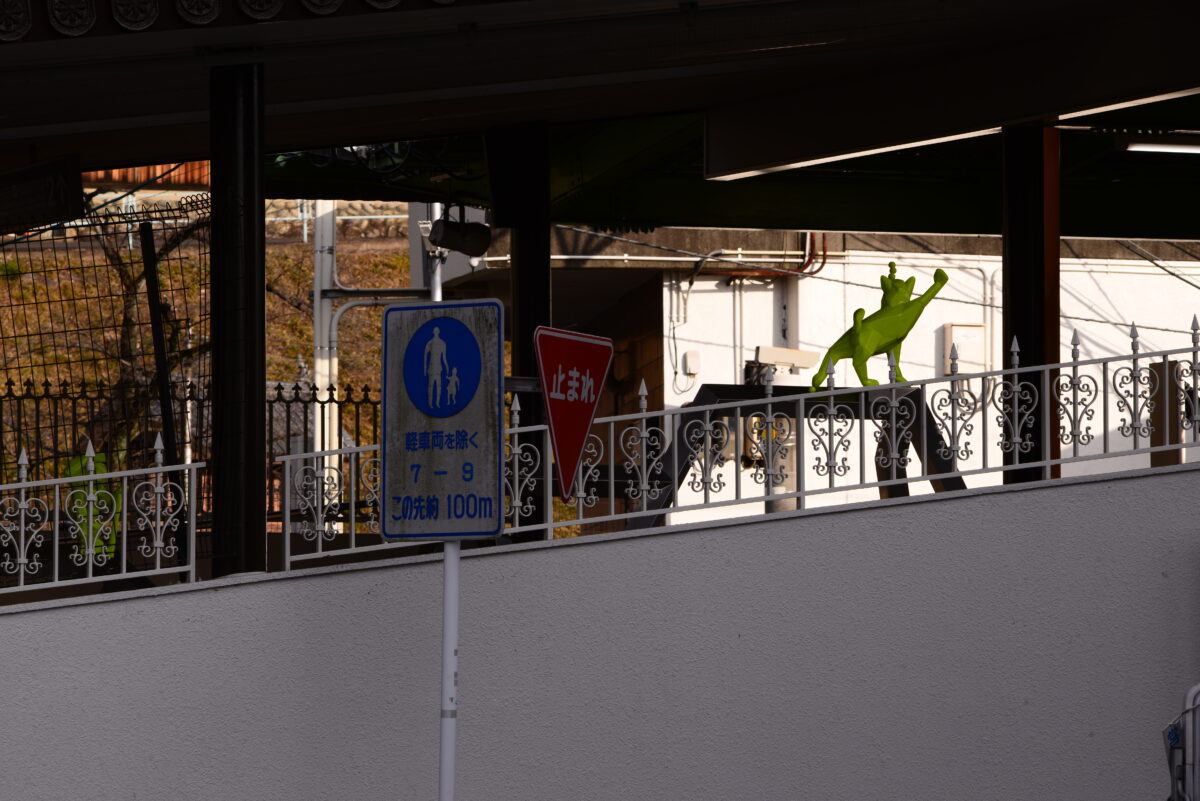
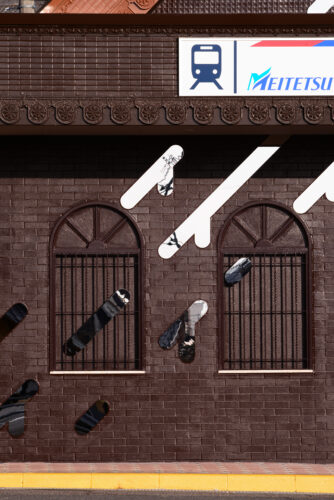
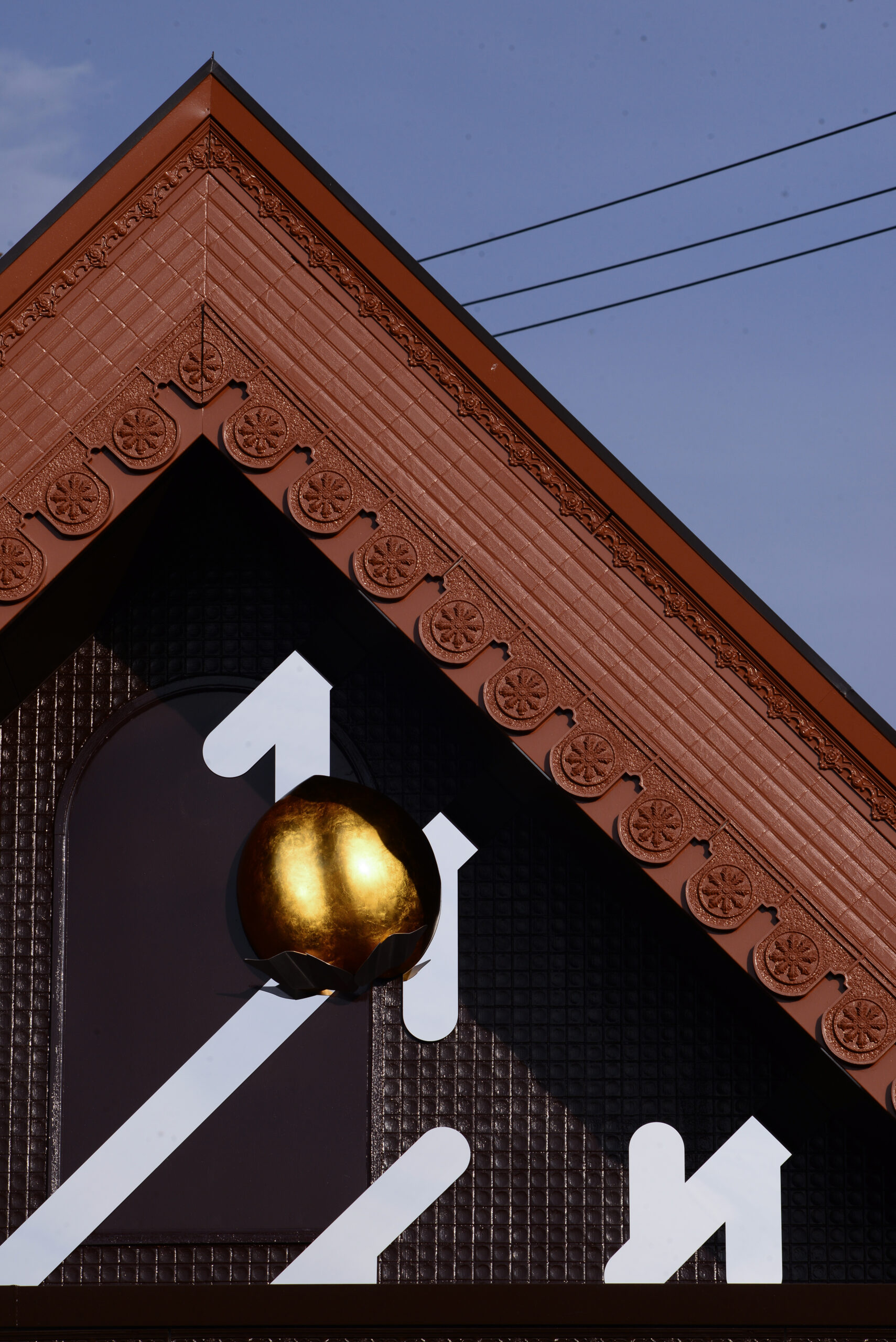
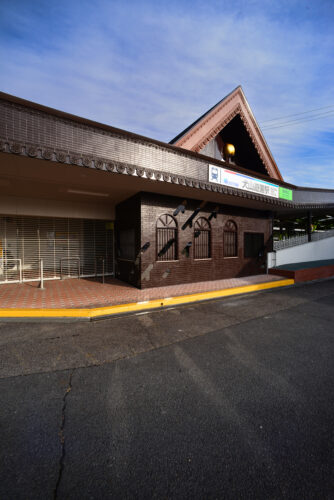
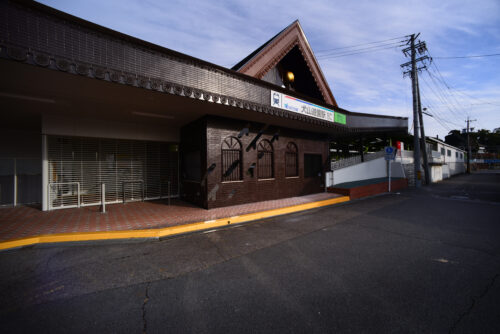
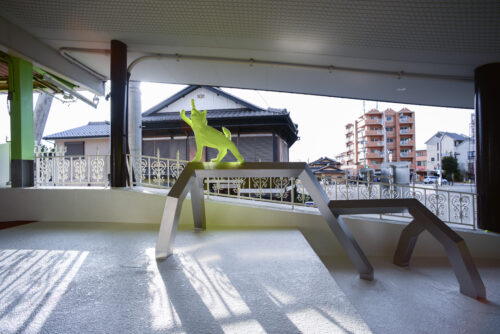
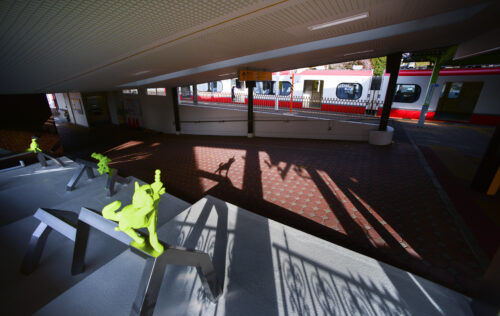
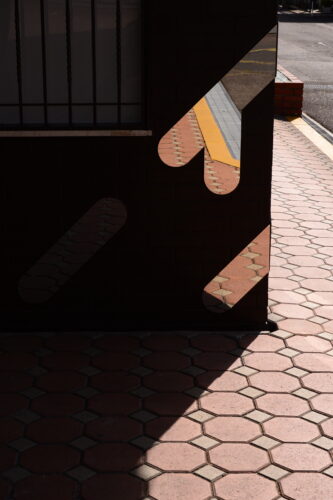
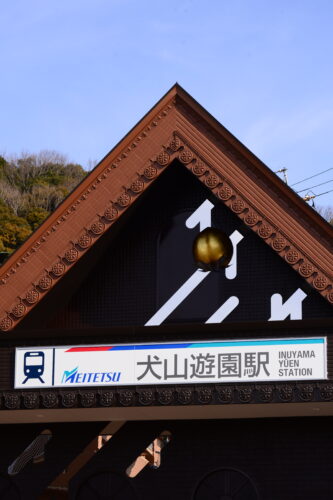
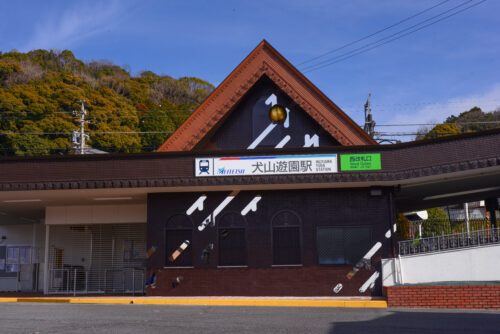
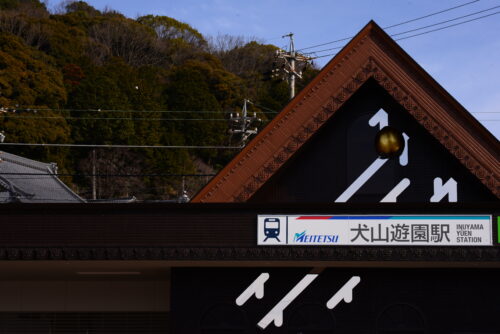
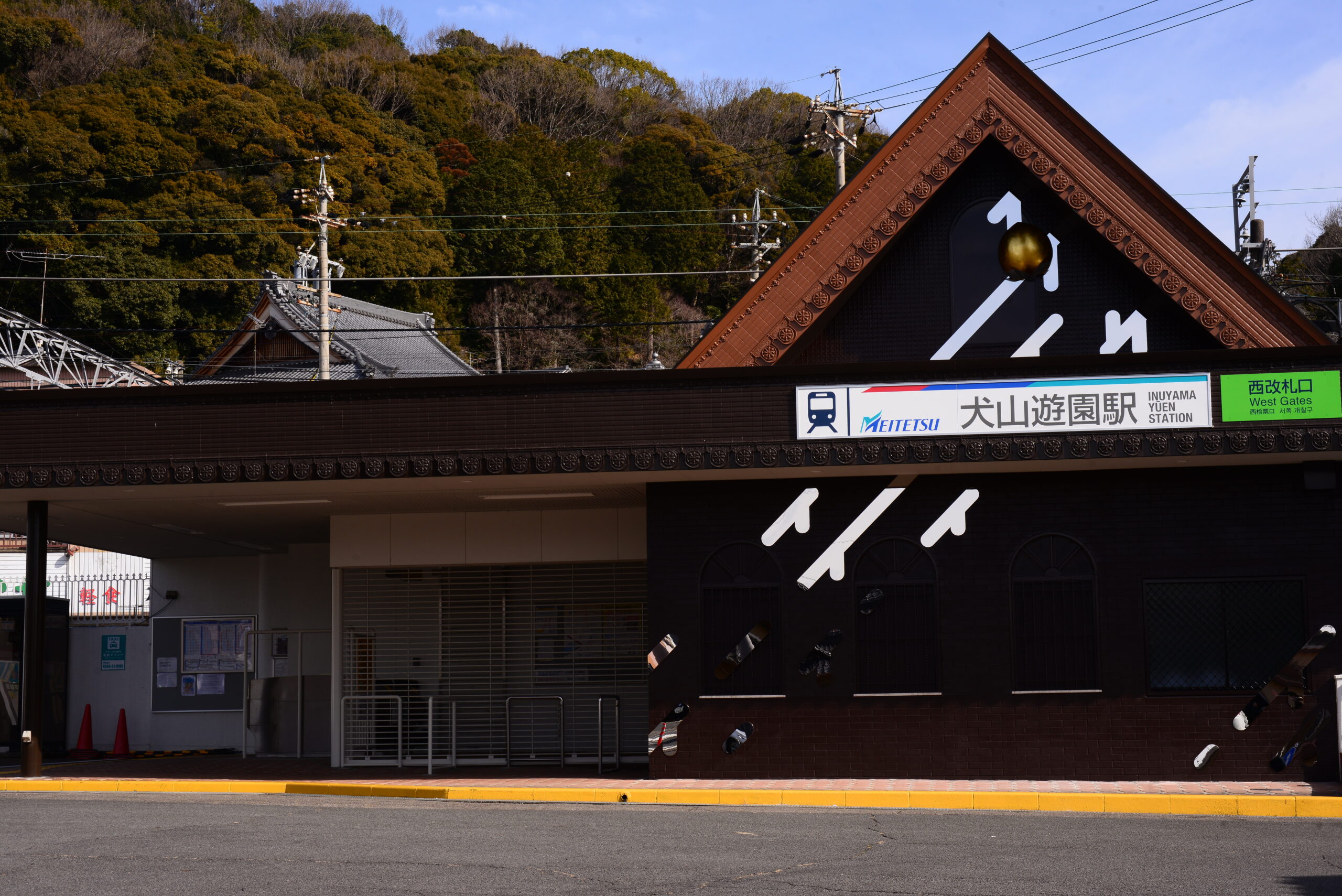
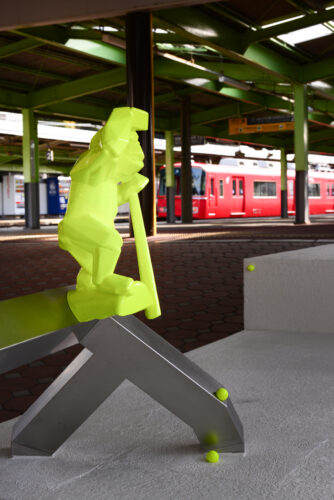
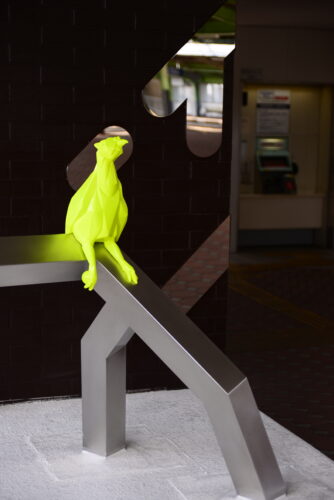
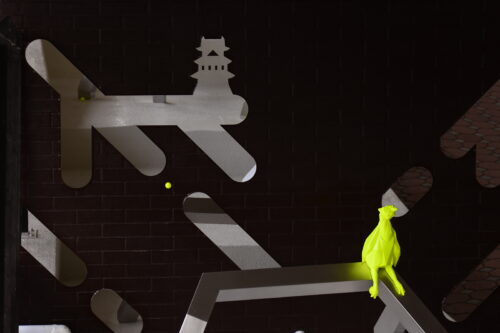

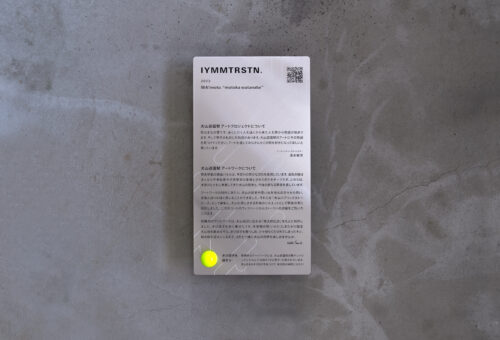

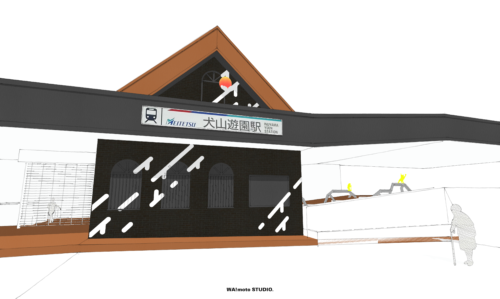
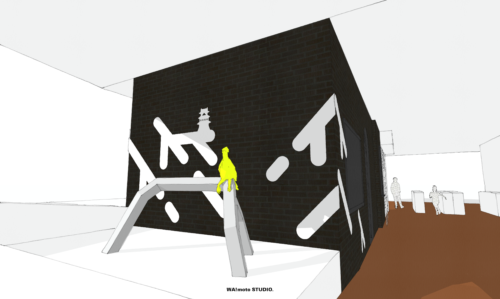
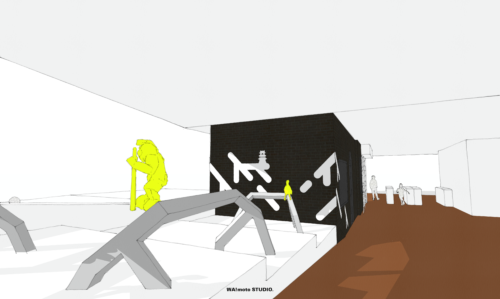
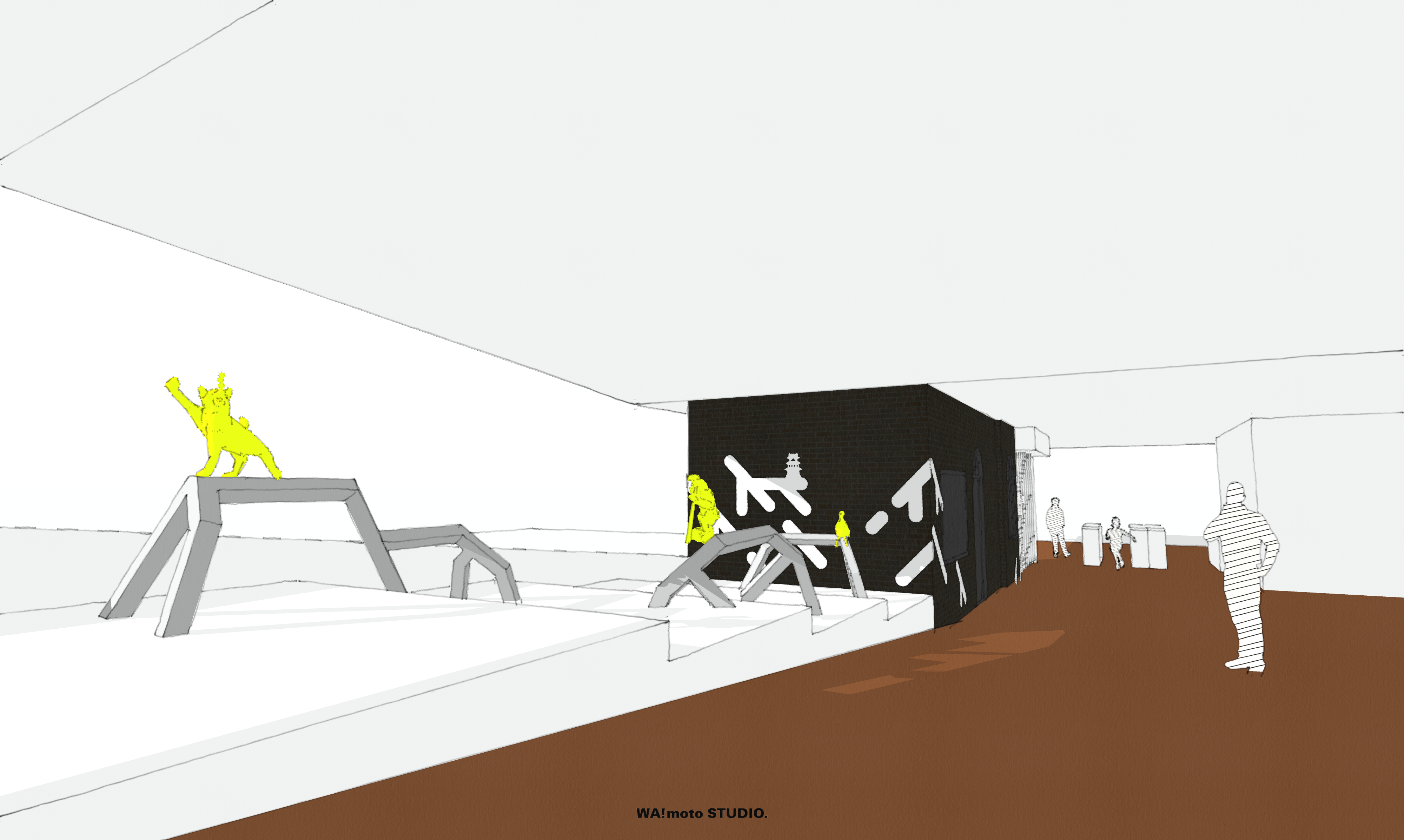
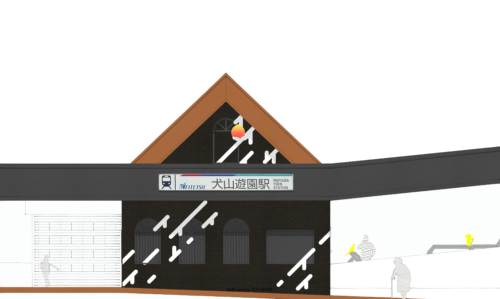
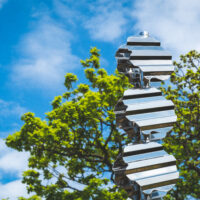 Nine Incentives H.
Nine Incentives H.